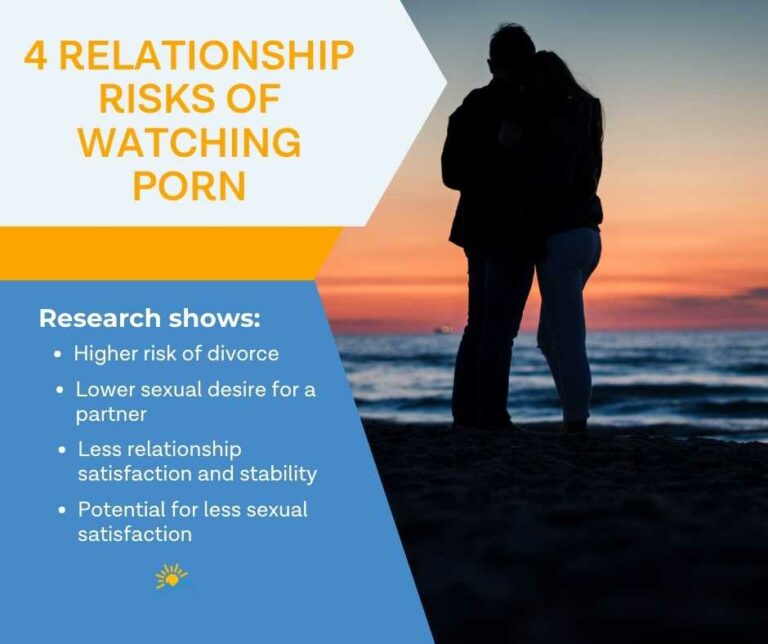Regardless of your religious or moral beliefs about pornography, viewing pornography is harmful. The sheer amount of pornography available to both kids and adults represents one of the most significant threats to public health in our modern era.
We understand why some people may feel like that’s a dramatic statement. It’s common in the media to hear that pornography is a problem only for the religious, as religious groups and individuals tend to grab headlines with fierce concern about porn.
Aren’t religious people overly-anxious about porn?
Almost all religious groups hold moral stances against pornography and often are quite vocal about this opposition. For example, the Religious Alliance Against Pornography is made up of various religions who are all banding together to fight porn. Or consider a recent news article about the Swedish Church fighting against pornography. Most religious groups oppose porn based on purity, chastity, and morality-based grounds.
For those who do not hold to chastity or religious-based views, then, porn may seem totally harmless. You’ll hear stories that make you think that porn is only a problem if you make it a problem. For example, there’s a study showing that religious people are more likely to think that they are addicted to porn, even though porn addictions are less common than they might realize. You would not be alone in thinking it’s harmless, as research suggests that over 70% of adult men and women approve on some level of pornography use.
All this is to say, what is the big deal about porn? How does porn make life hard?

How common is porn?
To understand why you should start caring about the effects of porn, we must start with how it has slowly become one of the most common sexual behaviors in the world. Pornography use has become increasingly common in the last two decades, thanks in large part to the multi-billion-dollar porn industry pushing its content out any way it can.
Consider these statistics. In a recent national survey from the United States, over 70% of both married and single men reported at least monthly pornography use. About a third of all men reported viewing pornography at least on a weekly basis. The same survey found that over half of all adult women also reported at least monthly pornography use.
Another growing trend noted by this study is romantic couples viewing pornography together. It’s reported that about half of all committed couples in the U.S. now report some degree of regular pornography use together. Another recent research study found that pornography use among young adult men rose by about 20% in the last 40 years, increasing roughly 5% each decade.

Parents are often in denial about what is happening to our children and teens when it comes to porn. Another research study reviewing pornography use among teenagers noted that about 1 in 5 children in the United States between the ages of 10-12 have viewed pornography and over 60% of all teenagers have been exposed to pornographic content.
Pornography is obviously quite common—so it can’t be that bad, right? The short answer is yes, it can. Regardless of your moral or religious stance, pornography does a lot of damage at the individual, couple, and even societal levels.
Here are a few important things to consider.
First, the amount of damage caused by occasional porn use is not going to be the same for each individual or couple. Your personal religious and cultural beliefs, morals, and values can influence how much porn impacts you. Even so, regular porn use can still cause problems for anyone at the individual and couple levels, as we will get into more later.
Also, it’s vital to remember that even if you think porn has no effect on you or your relationships, pornography consumption has a direct impact on public health. The pornography industry is a huge money-maker that is almost completely unregulated. It benefits from the exploitation of women and girls. The industry capitalizes on common beliefs that it is harmless, or that deviant porn is a way for people to explore their “kinks” safely.
While we don’t shame people for having various sexual desires, consuming pornography has hidden harms. You are not assured porn involves consenting adults. The effects of porn go beyond just your life, your wellness, and your relationships to directly harm victims. For example, Pornhub was recently exposed for failing to screen millions of uploaded videos, many of which involve filmed rape, incest, even child sexual abuse material.
Though it is difficult to reach and interview porn actors, some interviews have been conducted by Fight the New Drug that illuminate a troubling pattern. Low income porn actors are often coerced into saying that they consented at the end of films before they are paid. Admitting they were abused would risk not getting paid or rehired. For many actors, porn is definitely not harmless.
Finally, we want to make sure you know that we are not here to shame you or anyone else for having the desire to look at porn. After all, human beings are innately curious about bodies and sex.
Whatever your personal beliefs, we know that shame can increase issues with porn. We do not want to add to that shame! Instead, we want to help people understand the realistic, science-based effects of porn. Be kind to yourself as you learn about the damage porn can do. Also, be patient with yourself if you are starting out on a recovery journey.

3 ways porn makes life hard
1. Porn destroys freedom.
First, porn destroys personal freedom because it has the potential to create addiction. Not everyone will get addicted to porn, but some may still develop compulsive porn consumption.
Porn is not addictive for the same reason drugs and alcohol are. With drugs and alcohol, the brain develops a dependence on the chemicals that are introduced into the brain. Porn is addictive on the behavioral level, due to the feel-good chemicals that the body produces naturally when using porn.
The World Health Organization recently recognized compulsive pornography viewing as one of the ways that Compulsive Sexual Behavior Disorder can manifest. Due to porn being easier to access than drugs and alcohol, people can view it anonymously from just about any location or device.
Once people develop a dependence on porn, because of its addictive properties, porn can be incredibly difficult to quit. For those who have compulsive or addictive tendencies with porn, there is even some evidence of changes in the brain, making it even more difficult to quit.
Addiction does not happen overnight. It occurs very gradually, starting with an initial escape. Porn allows for an escape from discomforts in life, and it is accompanied by a rush of feel-good chemicals produced in the body. Because it feels good, and helps people escape their emotions, many can start to become preoccupied by porn.
However, that good feeling decreases over time with more use. Then even more is needed to chase that “high,” so to speak. Compulsive pornography use occurs when you feel like you need it constantly.
Porn compulsions and addictions can lead to a neglect of health, interests, responsibilities, and the erosion of marriages and relationships. People may start to prioritize porn over dreams and goals, making it very difficult to succeed in life, let alone maintain basic health, hygiene, and financial wellness. Feeling like you’re unable to follow through on your commitments because of an addictive behavior is a huge blow to self-esteem and personal empowerment.

2. Porn destroys relationships.
Porn also has the potential to destroy relationships. In fact, this is one of the most consistent findings in the research on pornography. You may be asking yourself how that makes sense if half of all couples watch porn together? It’s not like half of all couples are suddenly breaking up.
You’re right, but the answer lies in understanding that relationships don’t exist in a reality where they are either 100% healthy or 100% unhealthy. Like all relationships, romantic relationships exist on a spectrum.
Even if you consider a simple 1-to-10 point scale, you can understand this principle. Pretend that 1 represents the worst relationship possible and 10 represents the best relationship possible. Research has shown that watching porn is associated with these risks:
- less relationship satisfaction
- less relationship stability
- higher risk of divorce
- lower sexual desire for a partner
- potential for less sexual satisfaction
What this research is not saying is that porn takes“10” relationships and makes them “1” relationships, at least in most cases. Instead, what experts believe is happening is that porn is often pushing the relationship down a few points on the scale. That means if your relationship was a “9”, it may be a “7” with porn. If it was a “7”, it may be a “5” with porn. These relationships are still technically happy and may even be satisfying!
However, porn is limiting and lowering how happy and satisfying they are. To put it another way, porn limits your ability to have the happiest and most stable relationship possible.
Why porn damages relationships
Relationships are partly damaged because people want to act out what they see in porn. Typical porn scenes are based on what are called sexual scripts—or the underlying expectations and beliefs about how sex and intimacy “should” be.
Porn is filled with people doing things together that are not typical (or enjoyable) for women a lot of the time, leading to expectations to act those things out. This is especially an issue among men, who will often request sex acts they see in porn. Some even becoming dependent on conjuring up images from porn to stay aroused during sex. It’s probably obvious to see how this can quickly lead to dissatisfaction with a partner and sex due to the influence of porn.
Pornography can further damage healthy adult sexual behavior in other ways. Porn typically depicts a lack of clear consent, and leads to a higher acceptance and approval of rape and sexual violence. Further, research is showing a disturbing pattern where porn can directly lead to increased violence against women, both sexual and nonsexual.
Pornography also typically depicts unsafe sexual practices, which can lead to more risky sexual behavior, such as more unprotected sex with multiple partners. Approaching sex the way it is seen in porn and acting these things out can create a rift between partners due to a lack of sexual and emotional safety, healthy communication, and even pleasure.
Another reason relationships are damaged by porn is the focus on scripts that can destabilize couples. Porn often features casual sex with multiple partners, which can lead to a distaste for monogamous and long-term relationships. This can lower relationship satisfaction and stability. Sadly, pornography can even make married couples more likely to divorce.
3. Porn destroys healthy expectations.
Sure, porn makes you feel good in the short term. But regular porn use can negatively impact your personal well being over time. Take mental health, for example. Pornography use is linked with depression, as well as a decrease in self-esteem. Porn is also filled with people who don’t look like the average person, leading to body image issues in men and women both.
This makes sense. How could you feel good about you or your partner’s body if you are comparing yourselves to those unconventionally attractive and thin, plastic surgery-filled bodies in porn?
From a feminist perspective, there are many reasons to avoid porn due to the way it warps expectations about gender interactions. Porn disrupts gender dynamics by promoting a highly victimized version of women, there solely for a man’s pleasure, and a dominant, aggressive version of men. These impact men’s and women’s sexual behaviors in real time.
Violent porn creates an increase in acceptance of sexual violence towards women, including rape. Porn that is degrading to women also leads to an increase in sexism, especially among men. If you believe that you are not vulnerable to this because you watch completely mainstream porn, that is not necessarily true. Even mainstream porn leads to increased objectification of women, most likely because rough, often degrading acts against women are now mainstream in porn.
Also, violent porn is hard to avoid, as somewhere between 37 to 88% of porn depicts violence against women who are often shown enjoying it. But even if you try to avoid that, multiple studies still link general exposure to pornography to increased verbal,physical, and sexual violence towards women. And just as porn increases sexual violence among men, it models for women and girls that they are meant to be subordinate and passive. This leads to the alarming reality that women exposed to porn are more likely to experience sexual victimization.
As we detailed above, the “scripts” that most of porn follows can lead to unhealthy expectations for relationships, which in turn degrades long-term relationship stability and satisfaction. Additionally, people who are addicted to porn can become desensitized to images of sexual acts, with some evidence showing that it leads to increased erectile dysfunction in men, including young men. Overall, commonly accepted scripts from porn can make people less likely to be satisfied in both their relationships and with sex generally.
How porn makes life hard for teens
It’s worth returning briefly to an important statistic referenced before. Most people begin to view porn when they are young teenagers. Additionally, the amount of porn that teenagers today are viewing is rising every year.
Many, if not most teens now have their first sexual experience with porn instead of an actual human being. Think about that!
Then consider the negative effects of porn listed above. Now think about all those negative effects of porn and imagine how they may affect a 15 year old….or a 12 year old…..or a 10 year old.
The effects are quite troubling when you break it down. Somewhere around 11% of adolescents become compulsive porn users, particularly those who struggle with depression and other mental health concerns. Teens are also highly likely to prefer violence and domination-themed porn, especially as they get older.
Adding to these concerns, adolescents who look at porn frequently have more sexually permissive attitudes about having casual sex with multiple partners and are more likely to engage in sexual activity at a younger age. Also, as the pressure increases to look and act like people in porn, more and more 13 to 17 year-olds are sharing nude videos and photos of themselves with others, such as boyfriends or girlfriends.
Revenge porn – where pornographic images are shared online non-consensually – is becoming increasingly common. Too often revenge porn involves minors. In other words, teens are at an alarming risk of having nude images of themselves shared online.
Regardless of whether you think adults should have the option of viewing porn if they choose, everyone should be concerned about the amount of free pornography that young teens can access. Consider the negative impacts it may have on their lives, and the ways porn makes life hard for everyone.

What porn does NOT do
We’ve laid out reasons you should be worried about porn and ways porn makes life hard. Certainly, you can see that there are many. However, we want to avoid unnecessarily exaggerating the picture. Below are some common myths we want to debunk.
1. Most people are not addicted to porn.
We talked about this already, but it is worth reiterating. Most people (about 90%) do not show an addictive or compulsive pattern of porn use. Regardless of how addicted you think you are, try to avoid labeling yourself as a porn addict until and unless you have spoken to a mental health professional about it. This should be someone who can tell you whether you are addicted based on their clinical expertise, and who can also support you through recovery.
Remember that religious people are more likely than nonreligious people to think they are addicted to porn. Thinking you are addicted to something can be quite distressing. Therefore, we recommend consulting with a professional before jumping to that conclusion.
2. Porn use does not necessarily escalate in violent content.
A common myth about porn is that people will get desensitized to soft core porn and move to violent porn, watching increasingly disturbing content over time. While this may be true for a subset of people, there is no evidence that it is a common theme among most porn users. In fact, a recent study showed that porn has generally not gotten more aggressive over the last decade, and people tend to give more likes to videos low in aggression, where women are clearly experiencing pleasure rather than pain.
Porn use tends to escalate over time, but not necessarily the level of violence that people prefer to watch, at least as far as the research shows so far. As with a lot of porn research, however, there is simply not enough data to draw concrete conclusions about some things, this being one of them.
3. Porn does not turn people into child abusers.
The final myth we want to be very clear about is that consuming porn does not cause people to want to consume child sexual abuse material (CSAM) or become pedophiles. Pedophiles may use pornography and illegal CSAM, but they already had pedophilic tendencies. There is simply no evidence that porn causes pedophilia.
What difference can I make?
Learn more about other ways porn makes life hard.
The best place to start is to start and keep learning. We have ongoing content on our blog, such as our articles: “Porn Industry Secrets- What They Don’t Want You to Know,” and “5 Ways Porn Ruins Lives.” You can also check out our sister site, Pornlies.com, where we personified the sneaky nature of the porn industry.
Share how porn makes life hard with others.
Disrupt the scripts and denormalize porn by educating those around you about the real harms of porn. This includes talking with the youth in your care. Some resources include the information in the piece you just read, or our piece on How to Talk to Teens about Porn [AP1] has in-depth information on how to approach this important conversation.
Get involved with fighting porn
Finally, there are many organizations fighting the good fight against pornography. As we mentioned before, the Religious Alliance Against Pornography is a religious-based anti-porn platform that aims to educate. They accept donations and want to hear people’s stories.
For a nonreligious organization, the National Center on Sexual Exploitation is doing fantastic work in policy, advocacy, research, and survivor support. Their aim is to protect and support people caught in exploitation and sex trafficking (also pornography-related), educate the public, and influence policy for good. Also, if you are an anti-porn company, you can partner with Ever Accountable to provide accountability software.
The very best thing you can do in this fight is to eliminate your own porn viewing, as consumption fuels the industry. If you are struggling to quit porn, we’re here for you! We help people overcome problems with porn. Click here to learn more about our services and accountability software which works by breaking down the anonymity and shame that feeds porn use. With support, anyone can overcome porn and make the world a safer and healthier place.
Works Cited
Religious Alliance Against Pornography: Addiction, https://www.religiousalliance.org/. Accessed 12 December 2022.
https://www.tandfonline.com/doi/pdf/10.1080/0267257X.2020.1798714?casa_token=9Scb4Z1adrsAAAAA:0F_sgJiiUlM1Z-I-F0g3_cCY5wQv5IqUkXxaw0Xzo-i89WM3ytzbEMhFH7DdecQ1Vne6pfXyNPxv.
https://fightthenewdrug.org/these-performers-expose-abuse-consent-issues-on-porn-set/.
https://www.nature.com/articles/npp201778.
https://www.tandfonline.com/doi/pdf/10.1080/08934215.2013.773053?casa_token=utnRq5wUTEAAAAAA:_Fql6EUmFF4TyYXsSGCesOO8Eq6aDhNky7mb6Jj3qk4wdB5oOreGiNAW9cZLRw0MqqqUu2kNfh_7.
https://journals.sagepub.com/doi/pdf/10.1177/1077801220971352?casa_token=RQ4eSFQG59sAAAAA:7L4BABvS-9bFPVTES-K85XeGPSM4eyG6HH69ZxVwqj-_ycRyDQ20qHWNV1n2_Hk4zaFt2clit52o.
https://journals.sagepub.com/doi/pdf/10.1177/2374623816668275?offset=1389158280000.
https://www.tandfonline.com/doi/pdf/10.1080/00224499.2019.1655522?casa_token=dePTTvLA4T0AAAAA:jp2n5a1F713TKzdFBwrroO7W_cqNyiOlNVNTU08gfVp1-Ox1uP1e9mJdAVXykQOzfaeBuCwQrBSX.
https://www.tandfonline.com/doi/full/10.1080/10720162.2011.625552?journalCode=usac20.
https://onlinelibrary.wiley.com/doi/full/10.1111/jcom.12201?casa_token=9Ti4Rr3xl3oAAAAA:QMlnxVegMvYO-uOvXLjczDOC5bi0I7_nZ-J2vsQ_xFPXVt9INmVfMkDjOkB64h6MFM7CxN8GCu1H48M.
https://d1wqtxts1xzle7.cloudfront.net/40216644/Association_Between_Pornography_Use_and_20151120-32022-hdyrji-with-cover-page-v2.pdf?Expires=1662441227&Signature=Oi7~Thk7ESiz0kHY-EPPonJ0vRGRGqw1IkfmjBUbjyEgxmxHKTTP~9jtXzWK1pGIcSe76bmOhAIxJ~pYxjpL6mVt1Si9LFk.
https://link.springer.com/article/10.1007/s10508-013-0116-y.
https://onlinelibrary.wiley.com/doi/pdf/10.1111/j.1475-6811.2010.01328.x?casa_token=pdF-KIONbCoAAAAA:_EAjM3t8Vn3B377t08oUjjDw2EFi0d8TKfUO60Jj1MdW63nEDNFK4ZwdfctyKsQNfZcakONSCPtv9Dal.
https://link.springer.com/article/10.1007/s10508-015-0562-9.
https://idp.springer.com/authorize/casa?redirect_uri=https://link.springer.com/article/10.1007/s13178-018-0345-x&casa_token=s5L34Q409d8AAAAA:2kToWoJg05EoWRetZdpnWrEGbFz-6wYig9mMKsIpYW0pKAwrg8o5UJoweOIdH-W1Q5cACon7kRboIEEv.
https://journals.sagepub.com/doi/pdf/10.1177/1359105320967085?casa_token=kNlTVNXW5S0AAAAA:PufCZe-7VyVf2u35af6R1WrSzf5tmsSKjnJZvhhHggtH_YadFGwBgZM_o6eSsXgjo4ccK_1yISt1.
https://journals.sagepub.com/doi/pdf/10.1177/1077801220971352?casa_token=RQ4eSFQG59sAAAAA:7L4BABvS-9bFPVTES-K85XeGPSM4eyG6HH69ZxVwqj-_ycRyDQ20qHWNV1n2_Hk4zaFt2clit52o.
https://repositorio.comillas.edu/xmlui/bitstream/handle/11531/50945/TFG-%20Sanchez%20Gonzalez%20Sandra.pdf?sequence=1&isAllowed=y.
https://par.nsf.gov/servlets/purl/10081287.
https://d1wqtxts1xzle7.cloudfront.net/46743921/Adolescents_Exposure_to_Sexually_Explic20160623-18005-xdq5h8-with-cover-page-v2.pdf?Expires=1662882269&Signature=Fl5jcf6TCpNt00drHoXaS~K-1l0AoIsP7cRA4ycJFDnVsyCT5sMK1CCEyGqORd82d9jYNd20K8eSb6c-iAmXAZyyuiXEzoF7.
http://www.awe.asn.au/drupal/sites/default/files/Crabbe%20Corlett%20Eroticising%20Inequality.pdf.
https://citeseerx.ist.psu.edu/viewdoc/download?doi=10.1.1.987.202&rep=rep1&type=pdf.
https://onlinelibrary.wiley.com/doi/full/10.1111/jcom.12201?casa_token=9Ti4Rr3xl3oAAAAA:QMlnxVegMvYO-uOvXLjczDOC5bi0I7_nZ-J2vsQ_xFPXVt9INmVfMkDjOkB64h6MFM7CxN8GCu1H48M.
https://journals.sagepub.com/doi/pdf/10.1177/1077801220971352?casa_token=RQ4eSFQG59sAAAAA:7L4BABvS-9bFPVTES-K85XeGPSM4eyG6HH69ZxVwqj-_ycRyDQ20qHWNV1n2_Hk4zaFt2clit52o.
https://connect.springerpub.com/content/sgrvv/27/3/378.
https://www.tandfonline.com/doi/pdf/10.1080/14681994.2017.1323076?casa_token=5TfHTpgamWAAAAAA:9WYPCxeJMYdSXHziVkBYjj63mjI6JDReiTTGbtSwBv8H8ScGi7VI5wqi41SOzjz6idhULbeVUTLE.
https://www.sciencedirect.com/science/article/pii/S0140197117300544?casa_token=Ulq58aG-6gQAAAAA:Hk3gxHCElGYeEFE4coKqPQXE0sZFDBN_gtxflJ5X6ULZ0rDp5u6QAQ6R4So_kkNpTAaMcZ3rAw.
https://www.tandfonline.com/doi/pdf/10.1080/00224499.2018.1451476?casa_token=R7cmSRpjYOoAAAAA:YvQes4S6O2I4RNNRFmSenmKi04Djz4zuQHU3VfRwNOd0acPvpNx3RX0JvB0AjaW5l1g4OjYe_LKi.
https://journals.sagepub.com/doi/pdf/10.1177/0002764208321339?casa_token=vmS6GHIVb-AAAAAA:udJm44NucRiFhUpVaQiZfbGmBAibFNgFtNbUbsVW-r0bbcIm3_FGAgkyzgWSE4Lkk6f3lSooukju.
“Home.” YouTube, https://www.mdpi.com/2076-328X/6/3/17/htm?utm_source=thearchive.me. Accessed 12 December 2022.
“ICD-11 for Mortality and Morbidity Statistics.” ICD-11 for Mortality and Morbidity Statistics, https://icd.who.int/browse11/l-m/en#/http://id.who.int/icd/entity/1630268048. Accessed 12 December 2022.
“National Couples and Pornography Survey 2021.” Wheatley Institution, 8 November 2021, https://wheatley.byu.edu/national-couples-and-pornography-survey-2021. Accessed 12 December 2022.
“Religious, moral beliefs may exacerbate concerns about porn addiction.” American Psychological Association, 6 February 2020, https://www.apa.org/news/press/releases/2020/02/religious-moral-porn-addiction. Accessed 12 December 2022.
Sussman, Steve, and Alan N. Sussman. “IJERPH | Free Full-Text | Considering the Definition of Addiction.” MDPI, https://www.mdpi.com/1660-4601/8/10/4025/htm. Accessed 12 December 2022.
“Swedish church fights against pornography.” CNE.news, 2 August 2022, https://cne.news/artikel/651-swedish-church-fights-against-pornography. Accessed 12 December 2022.
[AP1]
14-Day Free Trial
Protection From Pornography
Change your habits, change your life: Start our 14-day free trial to help get rid of pornography for good.



